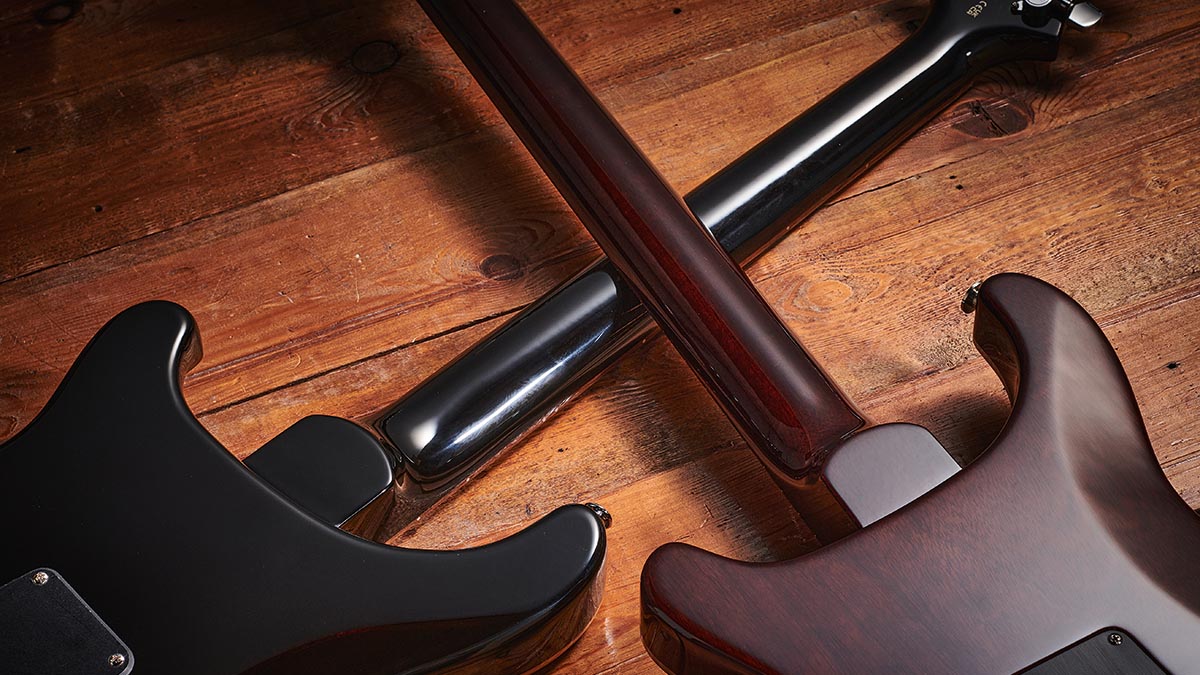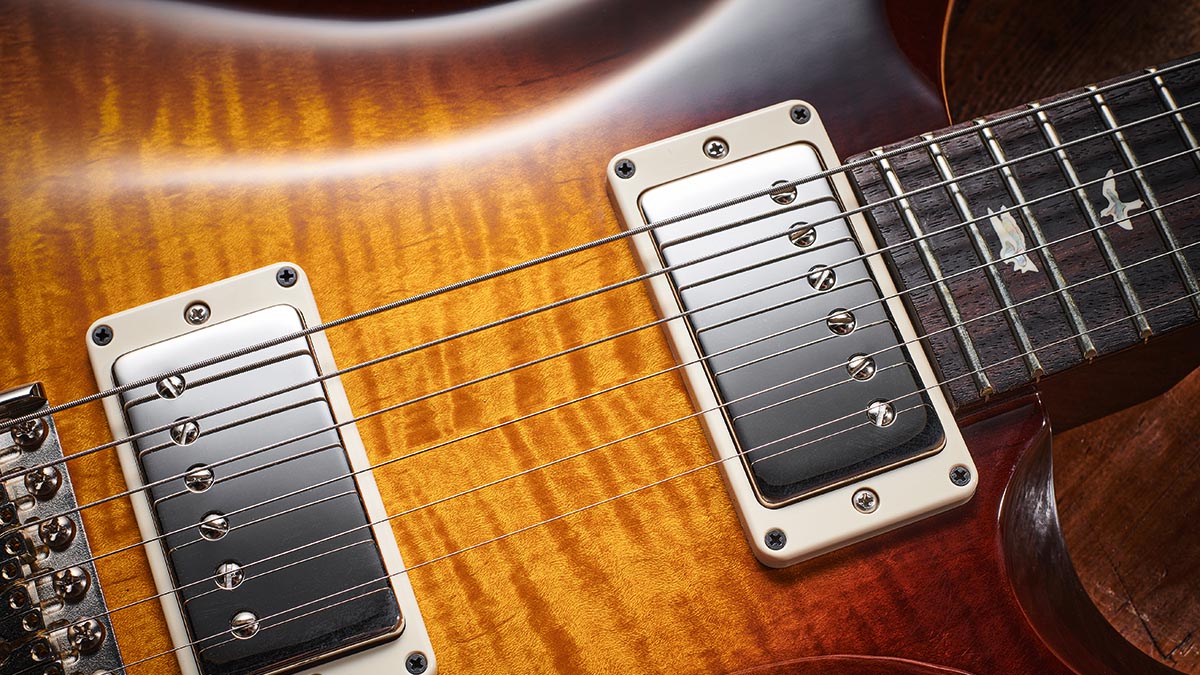PRS SE DGT vs USA Core DGT: what are the similarities, and how do the builds differ?
Less a copy, more an ‘inspired by’ design, the SE DGT cleverly emulates the USA model but with plenty of differences

As PRS’s Jack Higginbotham tells us, building the SE David Grissom wasn’t straightforward, not least that the signature guitar had to satisfy the “uncompromising soul” that is Grissom.
“The DGT is the result of a lot of years and a lot of gigs,” Jack tells us. “I think the difference is that David says, ‘This is what I want.’ David knows what he wants; he approaches the guitar like a guitar builder. He speaks our language.”
Let’s take a close look at the differences between the SE and Core DGT.
Headstock style

The very identifiable PRS headstock dates back to the first production guitars made in 1985. Both guitars appear to have the same back angle and pretty much the same thickness at just under 16mm. While many Core models use a headstock facing, the DGT doesn’t.
The signature logo is raised on the DGT and gold in colour, while the SE’s silver paint logo sits under the clear top coat and has the ‘SE’ ID underneath, of course. While both truss rod covers bear the same ‘DGT’ logo, the USA guitar’s is anodised aluminium and the SE’s is black plastic. The Core’s top nut is very smartly cut from bone; the SE uses a black synthetic material, a little taller than the Core model but nicely cut nonetheless.

The SE’s tuners are perfectly good generic enclosed-style but aren’t locking. They are contrasted on the Core model by the beautifully engineered and proprietary Phase III top-locking tuners with their open backs and unplated brass string posts. The cream ivoroid buttons reduce weight, too.
The SE clearly states who makes the guitar and where, although there’s no country of origin on the USA Core guitar, just the hand-written serial number beginning with the year of manufacture.
All the latest guitar news, interviews, lessons, reviews, deals and more, direct to your inbox!
Neck & Fingerboard
While the Core’s neck, back and headstock have a lightly translucent deep brown finish, the SE’s is opaque and is almost black in colour, which makes any comments about the wood or the construction underneath impossible. The Core’s Indian rosewood is a deep dark brown, the fret tangs easily visible on the sides.
The bird inlays here (moons are optional) use a vintage ivory coloured acrylic outline with green ‘standard’ abalone centres. The SE’s fingerboard, simply classed as rosewood, is noticeably lighter brown in colour with some striping and is actually bound by two thin stripes of the same material, which hides the fret tangs. The solid ‘old-school’ bird inlays of the Sunburst SE appear to be a pearloid and are less brightly coloured than the vivid birds of the Core model.
Likewise, the two-piece moon inlays on the Gold Top SE (not pictured) have a lot less contrast than the Core’s birds: the crescent moon is pearl-like and the ‘sky’ looks like a darker grey abalone or similar, but both could just as easily be synthetic.

We can only go by what we see, feel and measure and the specific neck size and shape of the Core model is a little different to the two SE samples we have to examine. The DGT’s nut width is quoted as 42.06mm but measures a little wider just where the nut meets the actual fingerboard at 42.6mm.
The SE’s nut measures 42.25mm, while the fingerboard just in front of that is 43.25mm. At the fingerboard end – so measured at the 22nd fret – the DGT is spec’d at 56.337mm and measures 56.42mm, while the SE measures 56.69mm.
The depths follow a similar pattern. At the 1st fret, the Core is spec’d at 21.41mm and measures 21.8mm; at the 12th it’s spec’d at 24.2mm and measures 24.3mm. The SE is only slightly deeper: 22mm at the 1st fret, 24.8mm by the 12th.
As for the frets, both use a pretty big wire, with the Core’s measuring approximately 2.74mm by 1.32mm, and the SE’s measuring slightly wider but pretty much the same height at 2.81mm by 1.3mm.

The Core’s fingerboard sides are slightly incurving, too, and the top edges are rolled to simulate wear, which gives a Core PRS a played-in, comfortable feel. The SE’s fingerboard edges seem a little squarer, although the top edges are rolled, but comparing the two, your hand tells you that the edges on the SE feel slightly ‘sharper’.
The actual neck profiles do feel very similar, with a very slight hint of a V in lower positions with a rounder, full C as you move up. Despite the slight dimensional differences, your hand would swear the SE neck feels slightly ‘bigger’.
PRS began using a larger heel on the 22-fret models of the early 1990s. Here, the heels both look very similar, although the SE’s is a few millimetres longer, extending pretty much 50mm from the body to the tip in the centre of the heel, while the Core is closer to 44mm.
Bodies
While the Core’s top carve has subtly changed over the years – not least when PRS moved away from its original dupli-carver to CNC – it’s one area that needs very careful hand-sanding, especially during the finishing process. It was never designed for mass production and, we’re told, still causes problems to this day.
The main surface of the SE’s ‘shallow violin’ carve is flat with the light contouring occurring on the edges only, and there are no divots under the controls or around the toggle switch.

Despite David Grissom’s request back in the day for a slightly thicker mahogany back bringing the overall depth of what was to become the McCarty to 52.2mm, this SE version is noticeably thinner overall at 45.25mm.
However, the mahogany back is slightly thicker than that of the Core DGT at 33.3mm as opposed to 30.6mm, while the maple top is thinner at 12mm against the Core version’s 20.5mm top. All this means that the mahogany-to-maple ratio of the SE is around 3:1 and on the Core DGT is around 3:2.
The Core DGT is the lightest in weight, too, at 3.35kg (7.37lb); our SE Gold Top weighs 3.51kg (7.72lb), and the sunburst model weighs 3.65kg (8.03lb).

The type of mahogany or maple isn’t specified on either guitar, but the Core uses one-piece stock for both the body and the neck with a centre-joined, book-matched top that has quite a subdued, classic figure.
You can see on the natural edge that the SE’s maple top is three pieces and on the sunburst uses a figured maple veneer that’s not book-matched, though has quite light figuring again. The yellow centre of the ’burst is a stronger colour with less brown bursting around the edges, notably the top horns, which contrasts the darker, older‑looking colour of the Core model.
Vibrato Style

The different vibratos are visually close cousins, but the Core’s Generation III vibrato is machined and uses brass for its full-size deep-drilled block, top plate and saddles. It also features tracks for the saddles to prevent any sideways movement.
The SE vibrato (also used on the S2 and bolt-on CE 24 models) is all steel and cast, not machined. Both have a push-fit tension-adjustable arm, and both appear to be stainless steel with a black plastic tip, though the SE’s is slightly smaller in diameter than the Core at 4.5mm, as opposed to 4.75mm.
Both SE and Core models have a pretty identical setup with very slight neck relief and a string height at the 12th fret of just over 1.5mm, slightly higher but barely so on the bass side
As set, there’s slightly less up-bend on the SE vibrato, which floats slightly closer to the body. But both SE and Core models have a pretty identical setup with very slight neck relief and a string height at the 12th fret of just over 1.5mm, slightly higher but barely so on the bass side.
The black plastic backplates that cover the vibrato springs and the control cavity aren’t recessed on the SE, whereas they are on the Core. The SE also uses a more generic metal ‘football’ jack plate as opposed to the Core’s classier rectangular anodised aluminium plate. Those PRS strap buttons (which are modelled after the string retainer of a Fender bass) aren’t copied on the SE model, which uses more generic-style buttons.

Pickups
As PRS players and fans will know, the company remains very secretive about what’s inside its pickups and, while never publicised, it’s fair to say the DGTs have been tweaked over the years.
Measuring the DCRs at output gives us approximately 8.72/5.83kohms for the full coil/split at the bridge, and 7.42/4.57k at the neck. The SE DGT ‘S’ humbuckers were designed in the USA and made in Indonesia by PSE, Cor‑Tek’s pickup-making division. The same full coil/split DCR readings are pretty close at 8.44/4.98k for the bridge and 7.43/5.08k for the neck.
Feel & Sounds
As we say, it’s a tall order to replicate a PRS Core model at 25 per cent of the price, not least that it’s a signature model designed to satisfy David Grissom. Face on, they look pretty similar, but as we’ve discussed the differences are there to see and feel once you have both in your hands.
From a player’s perspective, however, the almost less-fussy ‘Junior’ style of the SE certainly shouldn’t be overlooked. The key functional elements are replicated, and while the neck does feel a little bigger and perhaps not quite as elegant in style as the Core, in isolation it’s got quite an appealing ‘bigger old-Gibson’ vibe that’s very credible, especially if you like a little more meat.

Sound-wise, they’re not chalk and cheese – far from it, in fact. The Core DGT is very rounded in the high-end and smooth, which may be too dark for some, especially played clean.
Conversely, the almost bell-like response with a full virtually single-cut ‘body’ to the sound is huge. The SE does sound a little brighter with somewhat less body to the sound, but in the context of a band it’s certainly not £3k away. We found ourselves using the tone control more on the SE, namely to just pull back the brighter sparkle of the single-coil voices, which give the SE a little more of a contemporary sheen.
The Core model does sound older – it’s a little more mature. And it moves from classic Les Paul-like grunt to delicate jazzy and soulful rhythm fills with just a nudge of the controls. But, to be honest, we could say exactly the same about the SE.

Dave Burrluck is one of the world’s most experienced guitar journalists, who started writing back in the '80s for International Musician and Recording World, co-founded The Guitar Magazine and has been the Gear Reviews Editor of Guitarist magazine for the past two decades. Along the way, Dave has been the sole author of The PRS Guitar Book and The Player's Guide to Guitar Maintenance as well as contributing to numerous other books on the electric guitar. Dave is an active gigging and recording musician and still finds time to make, repair and mod guitars, not least for Guitarist’s The Mod Squad.
